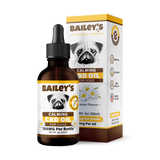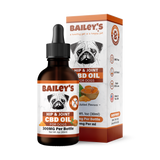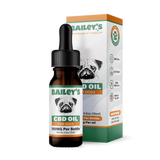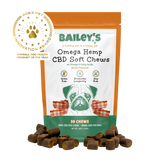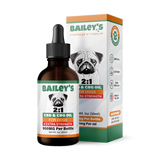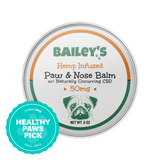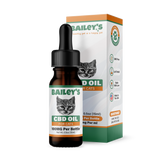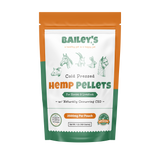Raw Chicken for Cats: Feline Feeding Caution

Feeding your feline companion a raw diet has become an increasingly popular choice among cat owners. However, it is essential to approach this dietary change with caution, particularly when it comes to raw chicken.
With the expert guidance of our friends at Bailey’s CBD , we will explore the potential benefits and risks of feeding cats raw chicken, as well as alternative options to consider for a balanced feline diet.
Table of Contents
1. Understanding the Feline Diet
A cat's dietary needs are distinct from those of other animals. As obligate carnivores, cats require a high-protein diet primarily composed of animal-based ingredients. This is due to their unique metabolic characteristics and evolutionary history.
1.1 The Role of Protein in a Cat's Diet
Protein is an essential component in a cat's diet, as it provides the necessary amino acids for growth, tissue repair, and overall well-being. Amino acids, often referred to as the building blocks of life, are crucial for the production of enzymes, hormones, and antibodies, supporting various vital functions within a cat's body.
When a cat consumes protein, it is broken down into individual amino acids during the digestion process. These amino acids are then absorbed into the bloodstream and transported to different parts of the body where they are utilized. For example, some amino acids are used for muscle development and repair, while others are involved in the production of hormones and enzymes.
1.2 Cats and Their Carnivorous Nature
In the wild, a cat's diet primarily consists of small prey animals such as mice, birds, and rabbits. These prey items provide cats with the necessary nutrients, including protein, essential fatty acids, vitamins, and minerals. Mimicking this natural diet is crucial for maintaining a cat's optimal health and vitality.
When a cat consumes prey, it not only obtains protein but also ingests other important nutrients. For instance, small prey animals are rich in essential fatty acids, such as omega-3 and omega-6, which are vital for a cat's skin and coat health. Additionally, these prey items contain vitamins and minerals that contribute to overall immune function and organ health.
Feeding a cat a diet that closely resembles its natural prey helps ensure that it receives a balanced and nutritionally complete meal. Commercial cat foods formulated to mimic a cat's natural diet often contain a combination of animal-based proteins, fats, and other essential nutrients. These diets are carefully formulated to meet a cat's specific nutritional requirements and are available in various forms, including dry kibble, wet canned food, and freeze-dried options.
It is important to note that while cats require a high-protein diet, it is equally crucial to provide them with the right balance of other nutrients. For example, excessive amounts of certain minerals, such as magnesium, can lead to urinary tract issues in cats. Therefore, it is essential to consult with a veterinarian to determine the appropriate diet for your cat based on its age, health condition, and specific nutritional needs.

2. The Raw Food Debate
The debate around feeding cats raw food, including raw chicken, is highly polarized. Proponents argue that a raw diet can provide numerous benefits, while opponents emphasize the potential risks involved. It is essential to weigh both sides of this debate before making an informed decision regarding your cat's diet.
2.1 Pros and Cons of Raw Feeding
Proponents of raw feeding often cite various benefits, including improved digestion, healthier coat and skin, and increased energy levels. They argue that feeding cats a diet that closely resembles what they would eat in the wild is biologically appropriate and can enhance their overall well-being.
Raw food advocates believe that a diet consisting of raw meat, bones, and organs can provide essential nutrients that may be lacking in commercial cat food. They argue that the natural enzymes present in raw food can aid in digestion and nutrient absorption, leading to better overall health for cats.
Furthermore, proponents argue that a raw diet can help prevent certain health issues commonly seen in cats, such as obesity and dental problems. They claim that the act of chewing on raw meat and bones can help keep a cat's teeth clean and strong, reducing the risk of dental disease.
On the other hand, opponents of raw feeding express concerns about the potential risks associated with feeding raw chicken to cats. Salmonella and other harmful bacteria are commonly present in raw meat, posing a significant health risk not only to cats but also to humans in the household.
They argue that the risk of bacterial contamination is particularly high when handling raw meat, and the potential for cross-contamination in the kitchen is a cause for concern. Additionally, opponents raise concerns about the potential for nutritional imbalances in a raw diet if not properly formulated and balanced.
2.2 Myths and Misconceptions About Raw Diets
As with any controversial topic, myths and misconceptions surround raw diets for cats. It is crucial to address these misconceptions and separate fact from fiction. Some common misconceptions include the belief that cats cannot contract foodborne illnesses or that they cannot suffer from nutritional imbalances when fed a raw diet. These notions must be dispelled to ensure informed decision-making in providing the best possible care for our feline companions.
Contrary to popular belief, cats are not immune to foodborne illnesses. While their digestive systems are more acidic than humans, making them less susceptible to certain bacteria, they can still contract infections from consuming raw meat contaminated with pathogens such as Salmonella or E. coli.
Moreover, nutritional imbalances can occur in a raw diet if it is not properly formulated. Cats require a specific balance of nutrients, including vitamins, minerals, and amino acids, to thrive. Without careful planning and supplementation, a raw diet may lack essential nutrients or contain excessive amounts of certain nutrients, leading to health issues over time.
It is also important to note that individual cats may have different dietary needs and tolerances. While some cats may thrive on a raw diet, others may experience digestive upset or other adverse reactions. Consulting with a veterinarian to assess your cat's specific needs and monitor their health is crucial when considering a raw diet; your veterinarian is your best resource for guidance on diet, supplements, and lifestyle needs.
As we see, the raw food debate for cats is complex, with valid arguments on both sides. Proponents believe in the potential benefits of a raw diet, emphasizing its biological appropriateness and potential health advantages. However, opponents raise concerns about the risks of bacterial contamination and nutritional imbalances. Ultimately, it is essential to gather all the necessary information, consult with professionals, and make an informed decision that takes into account your cat's individual needs and overall well-being.
3. Raw Chicken: A Closer Look
Raw chicken is often considered a staple in homemade raw diets for cats. However, assessing its nutritional content and potential risks is essential to understanding its role in feline nutrition.
3.1 Nutritional Content of Raw Chicken
Raw chicken is a rich source of protein, containing essential amino acids that support various bodily functions in cats. It also provides vitamins, such as niacin, vitamin B6, and vitamin B12, as well as minerals like zinc and selenium.
Protein is crucial for cats as it aids in muscle development, tissue repair, and the production of enzymes and hormones. The amino acids found in raw chicken help maintain a healthy immune system and promote proper growth and development in cats of all ages.
In addition to protein, raw chicken offers a range of vitamins that contribute to overall feline health. Niacin, for example, plays a vital role in energy metabolism and the function of the nervous system. Vitamin B6 is essential for brain development and the synthesis of neurotransmitters, while vitamin B12 supports the production of red blood cells and DNA.
Minerals found in raw chicken, such as zinc and selenium, are necessary for various physiological processes in cats. Zinc is involved in immune function, protein synthesis, and wound healing, while selenium acts as an antioxidant, protecting cells from damage and supporting thyroid function.
3.2 Potential Risks and Dangers
Despite its nutritional benefits, raw chicken poses potential risks and dangers that warrant careful consideration. The presence of harmful bacteria, parasites, and foodborne pathogens in raw chicken can lead to food poisoning and digestive issues in cats.
Salmonella and Campylobacter are two common bacteria that can be found in raw chicken. These bacteria can cause severe gastrointestinal problems in cats, including diarrhea, vomiting, and dehydration. Additionally, raw chicken may contain parasites such as Toxoplasma gondii, which can lead to toxoplasmosis, a potentially serious infection in cats.
Furthermore, the improper balance of essential nutrients can lead to nutritional deficiencies or imbalances, negatively impacting a cat's health over time. Feeding an unbalanced raw chicken diet may result in deficiencies of vital nutrients like calcium, phosphorus, or taurine, which are crucial for maintaining healthy bones, teeth, and heart function in cats.
When feeding raw chicken, it is crucial to implement proper hygiene practices and follow safe handling guidelines to minimize the risk of bacterial contamination and ensure the safety of both the cat and the household. This includes washing hands thoroughly after handling raw chicken, using separate cutting boards and utensils for raw and cooked foods, and storing raw chicken at the appropriate temperature to prevent bacterial growth.
Additionally, it is recommended to consult with a veterinarian or a feline nutritionist to ensure that the raw chicken diet is properly balanced and meets the specific nutritional needs of the cat. They can guide portion sizes, supplementation, and potential alternatives to raw chicken to ensure the cat's overall health and well-being.

4. Safe Handling of Raw Chicken
When introducing raw chicken into a cat's diet, it is vital to follow safe handling practices to reduce the risk of foodborne illnesses.
4.1 Proper Storage Techniques
Raw chicken must be stored at appropriate temperatures to prevent bacterial growth. Keeping it refrigerated or frozen until ready for use is key to maintaining its freshness and nutritional integrity.
4.2 Preparing Raw Chicken for Your Cat
Before feeding raw chicken to your cat, it should be handled and prepared with care. Thoroughly wash your hands, utensils, and surfaces with hot water and soap after handling raw chicken to prevent cross-contamination. Additionally, ensure that the chicken is sourced from reputable suppliers and properly inspected for quality and safety.
5. Alternatives to Raw Chicken
For cat owners who are hesitant about feeding raw chicken or prefer alternative options, there are other choices to consider.
5.1 Commercially Available Raw Food Diets
Several pet food companies offer commercially prepared raw diets formulated specifically for cats. These diets undergo stringent safety measures and are often balanced to provide the necessary nutrients for optimal feline health. It is crucial to research and choose reputable brands that prioritize quality and safety.
5.2 Cooked Chicken and Other Proteins
If raw feeding is not suitable for your cat or your circumstances, cooked chicken can serve as an alternative protein source. By thoroughly cooking the chicken, you can minimize the risk of bacterial contamination while still providing your cat with the essential nutrients found in chicken.
6. Conclusion
In conclusion, raw chicken can be a viable option for cat owners considering a raw diet for their feline companions. However, it is crucial to approach this feeding method with caution due to potential risks associated with bacterial contamination and nutritional imbalances. Safe handling practices and thorough preparation are essential when feeding raw chicken to your cat. Alternatively, commercially available raw food diets or cooked chicken can provide balanced alternatives to fulfill your cat's nutritional needs.
Remember, consulting with your veterinarian is always advisable before making any significant changes to your cat's diet, supplements, or routine care. By prioritizing your cat's health and safety, you can make informed decisions that contribute to their overall well-being and happiness.

